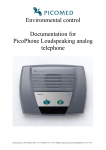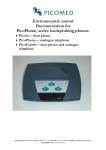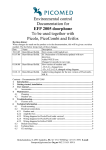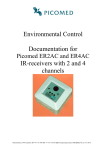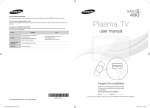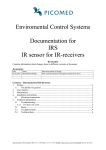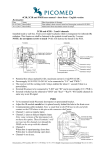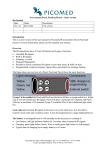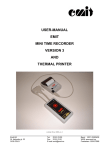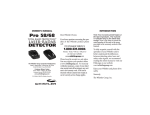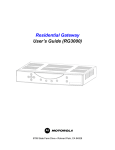Download Picomed PicoCombi User manual
Transcript
Environmental control Documentation for PicoCombi Loudspeaking analog telephone and doorphone Brokelandsheia, N-4993 Sundebru, Ph +47 3711 9950 Fax +47 3711 9951 E-mail: [email protected] Foretaksnr 962 211 631 MVA Revision history When changes are made on the product or in the documentation, this will be given a revision number. The list below keeps track of these changes. It will be signed by the person responsible for updating the documentation. Revisionlist: Dato 14.02.03 25.02.03 Navn Bent-Håvard Sollid. Bent-Håvard Sollid. 04.08.03 Bent-Håvard Sollid. 30.01.04 Bent-Håvard Sollid. 12.07.05 Bent-Håvard Sollid. 23.05.06 Bent-Håvard Sollid. Kort beskrivelse av endring First version with English text. Changed the appearance of the quick guide. Ch 3.17. Added wiring diagram between EFP-Picolo. Ch 7.2.2. Updated in accordance to SW version 1.02. • Changed record key for sound recordings. • Corrected IR-format compatibility. • Manual divided in 3 versions according to product versions. New version of EC Declaration of Conformity. Ch 7.6. Added information in drilling template. Kap 8. Removed electrical diagram for doorphone since this is a part of the documentation for the doorphone. Changed colours with reference to wiring for the EFP 2005. Ch 7.2.2. Updated in accordance to SW version 1.05 (disable ring-sound). Ch 1, 3.1.1, 3.4, 3.5.8, 4.3, 6. Changed revision list to updated look. Contents – Documentation PicoCombi 1 2 Introduction ...................................................................................................................... 4 Getting started .................................................................................................................. 4 2.1 Keys............................................................................................................................ 5 2.2 Light indicators .......................................................................................................... 5 2.3 Connections................................................................................................................ 5 3 User manual ...................................................................................................................... 6 3.1 Incoming call.............................................................................................................. 6 3.1.1 Disable ringing sound......................................................................................... 6 3.2 Outgoing call .............................................................................................................. 6 3.3 Telephone conversation.............................................................................................. 7 3.4 Doorphone conversation ............................................................................................ 7 3.5 Functions .................................................................................................................... 7 3.5.1 Stand by.............................................................................................................. 7 3.5.2 Hook off ............................................................................................................. 8 3.5.3 Conversation with doorphone ............................................................................ 8 3.5.4 Conversation with doorphone, parked telephone ............................................... 9 3.5.5 Volume adjustment ............................................................................................ 9 3.5.6 Auditive feedback .............................................................................................. 9 3.5.7 Voice message.................................................................................................. 10 3.5.8 Automatic answering function ......................................................................... 10 3.5.9 Telephone book ................................................................................................ 10 3.5.10 Tone generating................................................................................................ 11 3.5.11 Doorphone 1 and 2 ........................................................................................... 11 3.5.12 Power failure .................................................................................................... 11 3.5.13 Accessories....................................................................................................... 12 3.5.14 User manual - quick guide ............................................................................... 13 4 Programming .................................................................................................................. 15 PicoCombi loudspeaking analog telephone and doorphone Page 2. 5 6 7 8 4.1 Getting started .......................................................................................................... 15 4.2 Programming – plain ................................................................................................ 15 4.3 Programming – advanced......................................................................................... 16 4.3.1 Additional explanations for the table above 1) ................................................. 18 4.4 Programming – IR-training ...................................................................................... 19 4.5 Programming – back to default settings ................................................................... 20 Maintenance.................................................................................................................... 20 Trouble shooting............................................................................................................. 20 6.1 When errors arise ..................................................................................................... 21 Technical information.................................................................................................... 21 7.1 Fixed mounting ........................................................................................................ 21 7.2 Electrical connections .............................................................................................. 21 7.2.1 Fixed 12 VDC and external IR-sensor ............................................................. 22 7.2.2 Doorphone........................................................................................................ 23 7.2.3 Multiple indoor units........................................................................................ 24 7.2.4 Door indicator .................................................................................................. 24 7.2.5 External switches.............................................................................................. 25 7.2.6 External loudspeaker ........................................................................................ 25 7.2.7 External microphone ........................................................................................ 25 7.3 Jumpers..................................................................................................................... 25 7.4 Default (recycling) ................................................................................................... 25 7.5 Technical data .......................................................................................................... 26 7.6 CE markings ............................................................................................................. 26 Drilling template............................................................................................................. 28 PicoCombi loudspeaking analog telephone and doorphone Page 3. 1 Introduction This documentation are made for Picomeds PicoCombi loudspeaking IR-controlled analog telephone and doorphone, which is a part of Picomeds environmental system. It does not have any telephone receiver, only loudspeaking function. An external loudspeaker and/or microphone can be connected. It is controlled by a remote controller which transmits infrared (IR) signals. One can use Picomeds IR-remote controllers, or it is possible to let the device be controlled by a foreign IR-remote controller. There is a built-in IR-receiver, and in addition it is possible to connect two external IR-sensors. PicoCombi is designed for indoor use. Picomeds loudspeaking phones can be delivered in different variants. These are: • Picolo – doorphone with one or two outdoor devices. • PicoPhone – analog telephone. • PicoCombi – dual purpose doorphone and analog telephone. It is possible to record speech into it, and the recorded speech are divided into two types: • Auditive feedback which is ment to be used as guidance for the user about which functions are choosen. For example as a information about which digits pressed in a telephone number. • Voice messages which can be played back to the one you are speaking with in the telephone or in the outdoor phone. Switches can be connected to the loudspeaking products to control the main functions, in addition to external speaker and microphone. A built-in automatic answering function can be activated if required. There is a number of programmable settings to make. I.e the number of ringing signals before the automatic answering function triggers, disable ringing sound, which IR-format to be the active one, trainable IR and so on. 2 Getting started The following parts are included when the product is delivered: • Device. • Powersupply for connection to AC power outlet. • Telephone wire. • This documentation. In addition a remote controller which transmits infrared signals (IR) should be used to control the device to get full access to all functions. PicoCombi can be connected to 1 or 2 doorphone outdoor units which are not delivered with the apparatus. • • • Connect the power supply to a 230 VAC line and thereafter connect the output from the power supply to the connection point marked with ”12V” on the reverse of the apparatus. Connect the telephone wire to an analog telephone line and the other end of the wire to the reverse of the apparatus in the connection marked with ”Tele”. Connect wires from outdoor unit to the terminal strip inside PicoCombi (you have to loosen 4 screws in the bottom part of the unit to open it). You will find more information about this in chapter 7.2.2. PicoCombi loudspeaking analog telephone and doorphone Page 4. The device is now ready for use. When delivered, it is adjusted to be controlled by IR-format New Assistant with user code 5 (NA5). All channels from 0 to 15 (0-9, A-F) should be accessible on the IR-remote controller to control the loudspeaking devices fully. • • • • • An overview of the main functions are given in 3.5.14. A complete description of all functions are given in chapter 3. How to save numbers (up to 50 pcs) in the telephone book are described in chapter 4.2. To get the most out of all functions in the PicoCombi, the installer should go through all settings and make any changes in the advanced programming mode. This mode are described in chapter 4.3. It is recommended that auditive feedback is recorded before the unit shall be used. You will find more information about this in chapter 3.5.6 and 4.3. 2.1 Keys There are 3 keys on the front of PicoCombi. Denomination Function Telephone symbol Hook on/off, and to refuse anyone at the outdoor. Hand with telephone symbol Enable/disable automatic answering function. Door symbol Get in touch with anyone at the outdoor unit, and to unlock/open the door with. 2.2 Light indicators There are 4 light indicators on the front of PicoCombi. Denomination Function Power on Green. • Illuminates when power are connected to the device. Telephone receiver Red. • Illuminates when hooked off. • Flashing to indicate ”ready to hook off”. Automatic answering Yellow. • Steady on when automatic answering function is enabled. • Flashes slow in programming – plain mode. • Flashes fast in programming – advanced mode. • Double flashing in IR-training mode. • Triple flashing in default recycling mode. Doorindicator Red. • Illuminates when door is open. 2.3 Connections On the reverse of the PicoCombi there are the following connections: Denomination Type Function 1 3,5 mm monojack. External switch, phone book no 1. 2 3,5 mm monojack. External switch, phone book no 2. 3 3,5 mm monojack. External switch, phone book no 3. Door 3,5 mm monojack. External switch, doorphone Ph 3,5 mm monojack. External switch, telephone. 12V 4 pins ”telephonecontact”. Power connection. Only the enclosed PicoCombi loudspeaking analog telephone and doorphone Page 5. Tele • • powersupply must be used together with the device. Connection of analog telephone line. 4 pins ” telephonecontact” (6 pins wide). Mic 3,5 mm stereojack. External microphone. Sp 2,5 mm stereojack. External loudspeaker. Internal loudspeaker will automatically be disconnected when an external loudspeaker is connected. Internal microphone will automatically be disconnected when an external microphone is connected. 3 User manual PicoCombi can operate in different modes. These are: • Ordinary use. • Programming – plain. Programming made only by use of an IR-remote controller. This mode shall be used to save telephone numbers in the telephone book. • Programming – advanced. Gives access to advanced settings only. Ment to be used by technicians when installing the device. • Programming – IR-training. Let the device teach IR-signals from foreign IR-remote controllers. Make it possible to control it with other IR-remote controllers. In chapter 3.5.14 an overview of the main functions are given on one page. The page is ment as a quick guide for the user. 3.1 Incoming call PicoCombi gives a ringing signal to indicate an incoming call. You may hook off by the use of the remote controller, key on device, external switch or by the help of the automatic answering function if this is enabled. When the automatic answering function activates, there will be given a warning-tune, and then the PicoCombi hooks off after a predefined number of ringing signals (the number can be changed in advanced programming mode). 3.1.1 Disable ringing sound If the unit shall be used only for outgoing calls or, if there should be any other reason for not have the ringing sound be heard, it is posible to disable it for the telephone and/or the doorphone. If it is disabled, it will still be possible to use all functions. Contact your technician to get this altered if there is any need for it. 3.2 Outgoing call By the help of a remote controller or external switches it is possible to make a phone call. PicoCombi will wait for the dialling tone before the telephone number are transmitted. If the dialling tone not is possible to detect for the device, the number will be transmitted after a predefined time. All numbers will be transmitted as DTMF. PicoCombi can be programmed with a fixed prefix (i.e ”0”) to be used in combination with a telephone switch board. If a prefix is enabled, the device will wait for dialling tone after the prefix is transmitted. When the telephone book is used, the device will transmit the prefix automatically. PicoCombi loudspeaking analog telephone and doorphone Page 6. 3.3 Telephone conversation The telephone line will be active until: • The user disconnects (”hook on”) with the remote controller, key on PicoCombi, or an external switch. • The person you are talking to, hooks on. • If the conversation is started by the automatic answering function, it will be ended when the predefined conversation time (programmable in advanced programming mode) expires. In this case it will be given 4 warning tones before disconnection. 3.4 Doorphone conversation When a bell button is pressed a chime will sound (”ding-dong”) (not if ringing-sound is disabled, see chapter 3.1.1). To answer, do as follows: • Press the "D" button on the remote controller, or: • Press the door key on the PicoCombi, or: • Press key connected to external connection "Door" on the backside of PicoCombi, or: • PicoCombi will automatically establish connection after 5 seconds if automatic answering mode is enabled before the chime sounds. The connection will be enabled until: • The door is opened by: • Press the "D" button on the remote controller. • Press the door key on the front of PicoCombi. • Press key connected to external connection "Door". • Or until the connection is disabled without opening the door by: • Press the "E" button on the remote controller. • Press the telephone key on the PicoCombi. • Press key connected to external connection "Ph". • PicoCombi automatically disconnects after 45 seconds. It is possible to control 2 different outdoor units. The function is more detailed described in chapter 3.5.8. 3.5 Functions 3.5.1 Stand by 0 F 0 0 F ”hold Autoanswerekey” (on device) A <1-9> (direct dialling) <External switches 1-3> B <01-50> Entrance to Programming – plain. Entrance to Programming – advanced. • The autoanswering key on the apparatus has to be pressed maximum 3 seconds after the time when ”F” is released, and it has to be pressed for at least 3 seconds. Hook off and redial the last used telephone number. Hook off and transmit phone book number no 1-9. Hook off and transmit phone book number no 1-3. Hook off and transmit phone book number no 01-50. Two digits has to be pressed. • Telephone indicator flashes slowly after ”B” is pressed, and will illuminate steady after the second no is pressed. If it takes more than 5 minutes without any keys pressed PicoCombi loudspeaking analog telephone and doorphone Page 7. C <telephone number> E D Door key on device E Telephone key on device F Automatic answering key on device 3.5.2 Hook off <0-9> <External switches 1-3> A B C D Door key on device E Telephone key on device F Automatic answering key on device when telephone indicator flashes, the device will go back to standby. On hook dialling preparation. • The telephone indicator will be flashing when ”C” is pressed and it will illuminate steady when ”E” is pressed. If it takes more than 5 minutes without any keys pressed when telephone indicator flashes, the device will go back to standby. • The telephone number can contain the same characters as numbers in the telephone book, ref chapter 4.2. • External switch 1-3 (instead of a telephone number) will hook off and transmit telephone book number 1-3. Establish communication with primary or secondary doorphone. Hook off. Telephone indicator will illuminate. Enable/disable automatic answering function. Automatic answering indicator changes status. Transmit DTMF 0-9. Transmit phone book number no 1-3. Transmit DTMF *. Transmit DTMF #. Generate R-key signal = hook flash. Park a telephone conversation and establish communication to primary or secondary doorphone. End conversation. Volume adjustment in steps from 1-5. The value is saved independent of doorphone volume setting. Enable/disable automatic answering function. Automatic answering indicator changes status. 3.5.3 Conversation with doorphone <0-9> No function. <External switches 1-3> Ends conversation with doorphone, hook off and transmit number 1-3 from telephone book. A No function. B No function. C No function. D Open/unlock door (5 seconds active output) and thereafter Door key on device terminate conversation with doorphone. If beeper in doorlock are mounted, the user will normally hear this sound through the doorphone system. PicoCombi loudspeaking analog telephone and doorphone Page 8. E Telephone key on device F Automatic answering key on device End conversation with doorphone without open/unlock door. Volume adjustment in steps from 1-5. The value is saved independent of telephone volume setting. Enable/disable automatic answering function. 3.5.4 Conversation with doorphone, parked telephone <0-9> No function. <External switches 1-3> No function. A No function. B No function. C No function. D Open/unlock door and end conversation with doorphone Door key on device when dooropening signal has been activated in 1 second. Go back to parked telephone conversation (the user will be able to hear doorlock/dooropener operate for 1 second). E End conversation with doorphone without open/unlock door Telephone key on device and go back to telephone conversation. F Volume adjustment in steps from 1-5. Automatic answering key Enable/disable automatic answering function. on device 3.5.5 Volume adjustment Volume adjustments for the telephone function on PicoCombi may be adjusted with the remote controller in 5 steps. If the volume has been changed, the new value is stored and used for later telephone conversations. When pressing ”F” on remote controller the volume will increase and it will be indicated by one short ”beep” for each press. When changing from volume 4 to 5 (maximum) it will be indicated by a long ”beep”. The next keypress on ”F” will change the volume to 1 (minimum). The volume for the doorphone conversations are regulated with the same procedure as for telephone conversations. Telephone volume setting and doorphone volume setting are stored independent of each other. 3.5.6 Auditive feedback The following words can be recorded : "0-9", "*", "#", "Empty", "Saved", "Error" and "Pause". These words may be used as an auditive feedback in ordinary use, and while programming the device. If the user dont have any need for this auditive feedback it can be disabled (in advanced programming mode). Auditive feedback in advanced programming mode can not be disabled. If auditive feedback is enabled, it will be heard in the following situations: • When someone tries to transmit an unprogrammed telephone book number it will say ”empty”. PicoCombi loudspeaking analog telephone and doorphone Page 9. • • When someone transmits a telephone book number it will say the position of the number in the telephone book. When the keys for 0-9, *, # are pressed and the telephone line not is activated (”C”), every digit will be said. If the keys are pressed faster than the digits are presented, the feedback will not be stopped. It will be stopped when the keys ”E” or ”C” are pressed. 3.5.7 Voice message Three different voice messages with a duration up to 5 seconds may be recorded. 1, 2 or all 3 may be assigned to 1-5 different situations in a free order. When the situation becomes real, the message will be spoken automatically. The 5 situtations are: 1. Answer the doorphone. Initiated by the user or automatic answering function. 2. Unlock door and end conversation with doorphone. Initiated by the user. 3. End conversation with doorphone without open/unlock door (refuse visitor). Initiated by the user or timeout. 4. Answering incoming telephone conversation. Initiated by the user or automatic answering function. 5. End telephone conversation. Initiated by the user or timeout when using automatic answering function. Example: You may for instance record the following: ”Hi, this is John. I am not able to talk, but I understand what you say” as message number 1 (this is done in advanced programming mode). So, let message number 1 be ”copied” to situation 1 and situation 4 (also done in advanced programming mode). When John answer the doorphone (=situation number 1 in the list above) or if he is answering the telephone (=situation number 4 in the list above) message number 1 will be automatically played back in the beginning of the conversation. 3.5.8 Automatic answering function The automatic answering function can be turned on and off with an IR-remote controller or with the ”automatic answering function key” on PicoCombi. The function will be active both for telephone and for the doorphone. A light indicator will illuminate when the function is enabled. Please refer to chapter 3.1, 3.3 and 3.5.11 for more information. Be aware of the following: if this function is enabled, it is possible to call to the user and listen to what happens in the room. If the device is used by a disabled person without the capability to disable the function or to control the device him/herself, there can be a risk of involuntary monitoring of the person. Please also observe that if the ringing sound is disabled (ch 3.1.1) there will only appear a short tune until the user is connected to an incoming call. 3.5.9 Telephone book The telephone book in PicoCombi are able to: • Redial the last used telephone number up to 50 digits. • Store 50 telephonenumbers with up to 50 digits each. • Telephone book numbers 1-3 can be activated by external keys 1-3. • Telephone book numbers 1-9 can be activated by one keypress on the remote controller by pressing one of the keys 1-9. PicoCombi loudspeaking analog telephone and doorphone Page 10. The numbers in the telephone book will not deleted if a power failure situation occur. Redial memory will be deleted if a power failure situation occur. In advanced programming mode a prefix can be activated. This means that there is no need to save the prefix in all numbers in the telephone book if it is activated once in advanced programming mode. A pause (”F”) can be a part of a number in the telephone book. PicoCombi will wait a predefined time before the numbertransmitting continues if ”F” is a part of the telephone number. 3.5.10 Tone generating PicoCombi generate tones as a responce to user inputs. Generated tones will occur when: • Keypress on device (also if key has no action in actual setting) except from when DTMF are transmitted or when recorded speech are played back. • When a timeout occur after a ”B” or ”C” sequence in ordinary use. • When entering a programming mode. • When hook on is automatically executed. 3.5.11 Doorphone 1 and 2 PicoCombi can be connected to 2 different outdoor doorphone units. If both connections are used, doorphone 2 (defined as ”secondary”) will be the active one for 30 seconds (programmable time, can be changed in advanced programming mode) after a keypress on bell button at outdoor unit 2. This means that the user has 30 seconds (programmable) to answer the doorphone 2. If timeout, the user will get in connection with doorphone 1 (defined as ”primary” doorphone). The procedure for connection to doorphone 1 and 2 is the same for both. It is only possible to get in touch with one outdoor unit at the same time. When a bell button is pressed a chime will sound (”ding-dong”). A two way voice controlled communication will be established with the use of remote controller, door switch on device, external switch (connected to ”Door” at the reverse of the device) or automatically if automatic answering function is enabled. If the automatic answering function is enabled the communication will be established automatically 5 seconds (programmable) after someone has pressed the bell button. Before connection, there will appear a warning tone from PicoCombi. When the communication is established, the user may open/unlock the door. The signal to the dooropener/doorlock will be active for 5 seconds. The conversation at the doorphone lasts until the user himself disconnect, or until timeout (programmable). Before disconnection caused by timeout there will come a beep 5 seconds and a beep 2,5 seconds before the disconnection from the device as a prewarning. It is possible to let a light indicator illuminate when a door is opened. If this function is connected, the light indicator above the doorkey on PicoCombi will illuminate. 3.5.12 Power failure If a power failure come into being PicoCombi will go back to standby when the power come back, without any operations on it. It will be disconnected from the telephone line and the automatically answering function will have the same status as before the power failure. It will not be possible to operate the equipment when there is a power failure or the power supply is disconnected. Telephone numbers stored in the telephone book and all other settings will be unchanged. The redial memory will be deleted. PicoCombi loudspeaking analog telephone and doorphone Page 11. 3.5.13 Accessories The following accessories are available: • External switches to control telephone line, doorphone and phone book numbers 1-3. • Outdoor units for doorphone. • External IR-sensors. • External loudspeaker. • External microphone. PicoCombi loudspeaking analog telephone and doorphone Page 12. 3.5.14 User manual - quick guide Hook off (answer the telephone) • Press key ”E” Hook on • Press key ”E” Phone to someone • Press key ”E” • Press all digits in phone number Phone to a prestored number 1-9 • Press key 1-9 • PicoCombi automatically calls prestored number 1-9 Phone to a prestored number 10-50 • Press key ”B” • Press the 2 digits in prestored number (10-50) • PicoCombi automatically calls prestored number 10-50 On hook dialling preparation • Press key ”C” - slow blinking telephone light indicator • Press all digits in phone number • Press ”E”. PicoCombi automatically calls number Repeat last used telephone number • Press key ”A” • PicoCombi automatically calls last used number Volumecontrol • Press key ”F” when you are speaking in the phone • A long "beep" indicates maximum volume Automatic answering mode • Press key ”F” in standby mode, or: • Press "automatical answering mode" key on PicoCombi • A yellow light indicator indiactes enabled function • PicoCombi hooks off automatically after 5 ringing signals • PicoCombi enables doorphone automatically after 5 seconds • PicoCombi hooks on after 30 seconds telephone conversation • PicoCombi disables doorphone after 45 seconds • Manual hook on can be done with "E" Store prestored numbers 01-50 • Press keys ”0-F-0” in sequence. A loong beep will sound • Press the 2 digits in prestored number (01-50) • Press all digits in phone number, maximum 50 digits • Press key ”D” to save • Repeat points 2-4 to save more than one number • Press key ”E” to exit Answer doorphone • Press key ”D” • To open door, press ”D” once again • PicoCombi disconnect after 45 seconds • Manually disconnect with key ”E” Parking a telephone conversation - answer doorphone • Press key ”D” Open door - return to parked telephone conversation • Press key ”D” Disconnect doorphone - return to parked telephone conversation • Press key ”E” (does not open door) Brokelandsheia, N-4993 Sundebru, Ph +47 3711 9950 Fax +47 3711 9951 E-mail: [email protected] Foretaksnr 962 211 631 MVA 4 Programming PicoCombi may be programmed in different ways. • Programming – plain: Save and edit telephone numbers in telephone book. • Programming – advanced: Adjustments ment to be performed by a technician. • Programming – IR-training: Copy and ”learn” foreign IR-signals. • Programming – default/recycling: Restore default settings. Observe that: • When installing a PicoCombi you should as a first job enter advanced programming mode and record speech to the auditive feedback (point 31 in the list). This should be done because this feedback will be a very good help in programming mode. • In programming mode the device will not respond on door bell or telephone call. • The device will leave programming mode if no keys are pressed within 60 seconds. • If auditive feedback is needed in ordinary use, it has to be enabled (point 4 in the list). Specific for plain and advanced programming mode: • PicoCombi leaves programming mode if any keys on device is pressed. • The ”D” key can be pressed everywhere in the programming mode. When a ”D” is pressed at the end of a programming sequence it means ”store value”. If ”D” is pressed in the middle of a sequence the sequence can start from the beginning again, without storing any values. • The ”E” key can be pressed everywhere in the programming mode to leave the mode. • Invalid keystrokes will be indicated with the auditive feedback ”error”, and the sequence are ready to start from the beginning. This is one situation where it is important to have done the auditive feedback recordings in point 31 in advanced programming mode. 4.1 Getting started • When installing a PicoCombi you should as a first job enter advanced programming mode and record speech to the auditive feedback (point 31 in the list). This should be done because this feedback will be a very good help in programming mode. • First of all; decide which type of programming mode should be entered. • Enter programming mode as described in the actual chapter. • An IR-remote controller has to be present to perform plain and advanced programming. • As a default value, the device responds to IR-format New Assistant user code 5 (NA5). • If no remote controller with NA5 is present, an other remote controller can be used. In this situation the device has to learn the IR-signals. Execute the IR-training process in chapter 4.4 first. 4.2 Programming – plain In this mode it is possible to store, edit and delete telephone numbers in the telephone book. Auditive feedback is indicated with italic letters. To enter this mode do as the following text says: 1. Press ”0 – F – 0” on remote controller when device is in standby mode. 2. When entering programming mode, it will be indicated by a slow flashing light indicator for the automatic answering function. 01-50 <Existing number <telephone number> D PicoCombi loudspeaking analog telephone and doorphone Saved Telephonenumber Page 15. 01-50 • • • >/ Empty <Existing number >/ Empty Pressed numbers D Saved will be stored. Telephonenumber will be deleted. When a telephone book number is given, the stored telephone number will be played back digit by digit. If no number is stored, the word ”empty” will be played back. When a number is entered, all digits will be played back one for one. If the keystrokes are faster than the speech, the digits will be queued and played back one for one. The playback will be interrupted by key ”D” (store) or ”E” (exit programming mode). If more than 50 digits are entered, all digits after the 50th will be ignored. The ignored digits will neither be played back. The telephone numbers may contain the following: Digit/letter Belonging playback Function 0-9 0-9 DTMF 0-9 A * DTMF * B # DTMF # C Empty ”Clear”. Deleting all digits. Wait for new digits. F Pause Stores a pause with the same lengt as for the one programmed as a part of a prefix (done in advanced programming mode). 4.3 Programming – advanced It is ment that this mode shall be entered by technicians with a good insight in the product. It is important that the technician choose the best settings so the user can make the most out of the benefits of the product. Especially with the built in speech functions which are available. When installing a PicoCombi you should as a first job enter advanced programming mode and record speech to the auditive feedback (point 31 in the list). This should be done because this feedback will be a very good help in programming mode. Observe that: • Auditive feedback are indicated with italic letters. • Comma "," in the table indicate possible values, i.e "0,1" indicates "0" or "1". • Values in paranthesis are default values. • ”C” can be pressed everywhere in this mode. The sequence is interrupted and the device is ready for a new sequence. To enter this mode do as the following text says: 1. Press ”0 – F” on the remote controller while device is in standby mode. 2. Thereafter, and within 3 seconds, press and hold the key for ”automatically answering function” on the device for 3 seconds. 3. When the light indicator for ”automatically answering function” is executing rapid flashing you have entered the advanced programming mode. 4. Release the key for automatically answering function. For some of the lines here, there are given an additional explanation beneath the table. 00 SW version Version number readout. PicoCombi loudspeaking analog telephone and doorphone Page 16. 01 04 Stored digit 05 Stored digit 06 Stored digit 07 Stored digit/ -, 0-99 (-) Empty Pressed digit Stored digit 3-8 (3) Pressed digit D Saved D Saved 09 Stored digit D Saved 10 Empty D Saved Delete and deactivate learned IR. 11 Stored digit 100-999 (115) Pressed digit 0 Pressed digit 00-11b (10) Pressed digit Number of ringing signals before the automatic answering function activates. Number of seconds before the automatic answering function activates doorphone. Number of minutes open telephone line in automatic answering mode. No value indicates 30 seconds. Auditive feedback on/off. 0 = deactivated, 1 = activated. In ordinary use. Number of seconds open doorphone communication. Number of seconds from a bell button press on doorphone 2, until it not is the active doorphone anymore. Fixed prefix or not. The digit give the prefix. No value means no prefix. Maximum time in seconds after a prefix before the number is transmitted. Time will be shorter if dialling tone is detected. Number of milliseconds for R-key flash. D Saved 12 Stored digit D Saved 13 Stored digit D Saved User group for Gewa. 14 Stored digit D Saved 15 0 D Saved Activate New Assistant/Gewa lockcode. 0 = off, 1 = on. Value for New Assistant/Gewa lockcode. 161 Stored digit D Saved 17 18 19 20 211 221 231 24 25 261 Empty Empty Empty Empty Playback Playback Playback Empty Empty Stored digit/ Empty Stored digit/ Empty 0-31 (5) Pressed digit 0-3 (0) Pressed digit 0-1 (0) Pressed digit 0-4095 (0) Pressed digit 0-9, A-F (D) Pressed digit Activate IR-format, 0 = off, 1 = on. 1. Digit 1 indicate New Assistant. 2. Digit 2 indicate Gewa. User code for New Assistant. 02 03 08 271 Stored digit 3-20 (5) Pressed digit Stored digit 1-30 (5) Pressed digit Stored digit/ -, 1-99 (-) Empty Pressed digit 0,1 (0) Pressed digit 6-99 (45) Pressed digit 5-99 (30) Pressed digit D Saved D Saved D Saved D Saved D Saved D Saved Voice input Voice input Voice input –, nnn (-) Pressed digit –, nnn (-) Pressed digit Saved Saved Saved D Saved D Saved PicoCombi loudspeaking analog telephone and doorphone Indicate which ”key” the New Assistant /Gewa lockcode shall be assigned to. Not in use. Not in use. Not in use. Not in use. Record voicemessage 1. Record voicemessage 2. Record voicemessage 3. Not in use. Not in use. Activate voicemessage(s) for situation 1. (Answer doorphone) Activate voicemessage(s) for situation 2. (Unlock/open door) Page 17. 281 291 301 311 32 33 Stored digit/ Empty Stored digit/ Empty Stored digit/ Empty –, nnn (-) Pressed digit –, nnn (-) Pressed digit –, nnn (-) Pressed digit Voice input Stored digit/ 0, 1 (1) Empty Pressed digit D Saved D Saved D Saved D D Saved Saved Stored digit/ 0, 1 (1) Empty Pressed digit D Saved Activate voicemessage(s) for situation 3. (End conversation with outdoor unit) Activate voicemessage(s) for situation 4. (Answer telephone) Activate voicemessage(s) for situation 5. (End telephone conversation) Record auditive feedback words. Volumecontrol for the telephone. 0 = no ringing tone - telephone. 1 = controlled by potmeter. Volumkontroll dørtelefonlinje. 0 = no ringing tone - doorphone. 1 = controlled by potmeter. 4.3.1 Additional explanations for the table above 1) 16 When a lockcode is activated for a given key, then the other IR-format(s) will be deactivated for the actual key. 21-23 To record word/sentences press and hold the "F" key, talk the message, and release the key. The recording stops when the key is released, or the available time of 5 seconds are used. Then a long ”beep” appears, and the recorded message will be played back. The speech will be stored while recording it, not when pressing the ”D” key. Recording should be done in a silent environment with a clear voice with the mouth near the microphone which is situated in the left front corner of the device. 26-30 To activate a message, you may enter one, two or three digits (value 1,2 or 3) for each situation in the prefered order. The value indicates the number of the voice message. A description of each situation are given in chapter 3.5.7. A voice message has to be recorded before it can work. 31 Recording shall be done in this sequence: "0-9", "*", "#", "Empty", "Saved", "Error" and "Pause". Record one word and listen to the playback. Each word may be played back several times if necessary. If not approved, you may record again. There is 1 second available for each word. The following keys shall be used while recording: • F Record one word. Do it in the same way as described in point 21-23. OBSERVE: Read also text for key ”B/#”. • A Playback a recorded word. • B Go to next word in the sequence. If the last word is recorded, ("Pause") there will come 3 short ”beep” and the device are ready to record the first word ("0") in the sequence again. • D Finish the sequence. Start with "0", go on with ”1” and so on. ”Pause” is the last word. Important! • When installing a PicoCombi you should as a first job enter advanced PicoCombi loudspeaking analog telephone and doorphone Page 18. • programming mode and record speech to the auditive feedback (point 31 in the list). This should be done because this feedback will be a very good help in programming mode. Remember to activate auditive feedback in point 04 if this shall be active in ordinary use of the equipment. 4.4 Programming – IR-training When entering this mode, then the PicoCombi automatically will activate the trained IRformat, while the other IR-formats will remain unaltered. This means that it is possible to use more than one remote controller to control the device. To enter IR-training mode, only keys on the device shall be used: 1. Press and hold the automatic answering key. Light indicator changes as normal. 2. Press once on door key. 3. Press twice on telephone key. 4. Press twice on door key. 5. Release the automatic answering key. The automatic answering light indicator will start double flashing with a pause to indicate that mode IR-training is entered. Channel number is set to 0. Maximum time for the points above is 8 seconds. The word "0" (channelnumber is 0) will be played back. If there is no IR on the actual channel, the device will also play back the word ”Empty”. The device is now ready to train the channels 0-15. Observe that IR-training not can be done with IR-signals applied to the external IR-sensors. The following 3 things can be done: a) Train the device with an IR-remote controller. Point the remote controller against the IRreceiver placed under the dark glass in the front of the device. The distance from the front of the remote controller and the IR-glass on the device should be approximately 2-5 cm. Press the key designated to the channel number which are active1. After the first successful IR-training, the device will playback "Saved Beep". Then press the doorkey and repeat the IR-training once again with the same key. After the second successful IRtraining procedure on the channel the device playback "Saved Beep Beep". A double IRtraining is neccessary to manage IR-remote controllers which transmits different IRsignals when executing repeated keystrokes on the same key. b) Delete trained IR with a press on the automatic answering key. The device will playback ”Empty”. c) Go to the following channel number with a keystroke on the doorkey. The new channelnumber will be played back if it is among channel 0-11 (10 = * and 11 = #). The channels 12-15 will be indicated with a ”Beep”. If there isn’t any trained IR-signal on a channel, the device will also play back the word ”Empty”. When passing the last channel (15) the device will leave IR-training programming mode. To delete all trained IR-signals, enter advanced programming mode and execute the ”deactivate and delete IR” command, or make a recycling to get the device back to default settings. PicoCombi will leave IR-training on timeout. 1 One should give a very short and concise keystroke. PicoCombi loudspeaking analog telephone and doorphone Page 19. 4.5 Programming – back to default settings There is a 2-stage process to execute to get the PicoCombi back to default settings. This sequence is controlled by the keys on the device. • Step 1 restores all changeable parametres back to default settings. • Step 2 is a continuation of step 1, and if executed, all recorded speech will be deleted (words in auditive feedback and voice messages). Do as following: 1. Press and hold the key for automatically answering function. Light indicator for function will change as normal. 2. Press door key once. 3. Press 3 times on telephone key. 4. Press 3 times on door key. 5. Release the key for automatically answering function. Light indicator for function will start triple flashing. You will hear ” Beep-Beep-Beep" as a confirmation for a correct entered mode. 6. To start recycling: press the key for automatically answering function and restoring process starts. If the key not is released at once, but pressed for 3 seconds, also step 2 (delete all recorded speech) will be executed. The speech deleting process lasts for 5 seconds. A long ”Beep” will sound when the process are finished. Maximum time for the points 1-5 is 8 seconds. Maximum time between the points 5-6 is 8 seconds. When restoring the values, the following are done: • Alle telephone numbers in the telephone book will be deleted. • Redial memory will be deleted. • Volume level will be set to value = 3 for both telephone and doorphone system. • Automatic answering function disabled. • Alle values which can be altered in advanced programming mode will be set to default. • Trained IR will be deleted. 5 Maintenance Picomeds PicoCombi loudspeaking IR-controlled loudspeaking analog telephone and doorphone is developed to work without any sceduled maintenance. The equipment should be cleaned when neccessary. Wipe the equipment with a slightly damp cloth or an antistatic cloth. Never use a dry cloth, while this result in risk of static charges. It shall not be exposed for fluids in any way. 6 Trouble shooting If your equipment does not behave as expected, first of all try to solve the problem yourself using the following table. Symptom Completely dead. No light indicators illuminated. Possible cause • No power connected. PicoCombi loudspeaking analog telephone and doorphone Reccomended action • Ensure that the power supply is the correct one which was delivered with the equipment. • Ensure that the power supply is connected to a Page 20. • Very low volume in the speaker. No ringing sound. • • • Volume set to minimum. Device is covered. Ringing sound disabled for telephone and/or doorphone. Does not respond to IR• IR-glass in front of device remote controller. is covered. • Wrong IR-signals. There are no fuses inside the device which shall be replaced. • • • • • functioning wall outlet. Ensure that the power supply is properly connected to the equipment. Hook off, press ”F”. Remove covering. Contact your technician, enable ringing sound. Remove covering. Reprogram or do IRtraining once again. 6.1 When errors arise If there are errors which are not possible to solve, contact your supplier of the equipment, or the national distributor. Please make a note beneath of the telephone number to your supplier. Name Supplier: Telephone number, adress etc. National distributor: 7 Technical information The device is made by: • Injection moulded box in recycleable ABS. • Frontglass made of plexiglass (Polycarbonat). • 2 PCBs: a maincard in bottompart with contacs, and a keypad PCB mounted in top-part. • Microphone and loudspeaker mounted in rubber gaskets to dampen mechanical vibrations. • Frontfoil. Productname, light indicators and keys are visually viewed on it. 7.1 Fixed mounting PicoCombi are designed to be placed on a flat surface, or it can be hanged vertically with the help of the built-in screwholes. • Ensure that cables not are crushed between the device and surface. • The microphone is placed in the line between top and bottom part of the unit. When placed vertically on a wall, pay attention to the attenuation of the users voice if the unit are placed lower than the users mouth. • A drilling template is made and attached at the end of this documentation. 7.2 Electrical connections Severe terminal strips are placed inside the box. • Connections are made for cables of size 0,14-1,5 mm2 (35-16 AWG). PicoCombi loudspeaking analog telephone and doorphone Page 21. • • Remove insulation = 6 mm. The figure beneath shows the position for terminal strips, contacts and jumpers. 7.2.1 Fixed 12 VDC and external IR-sensor 0V 0 V. +12V +12 VDC fixed. Ment for IR-sensors and bell buttons. I < 65 mA. It can be used to supply IR-sensor and to control the doorindicator via a door switch (Ch. 7.2.4). LED Controls LED on external IR-sensor(s). IR IR-signal from external IR-sensor(s). 1 or 2 external IR-sensors (Picomed ES2) can be connected to the terminal strip. They will be supplied with 0 and +12 VDC together with LED signal from the device. The IR-signal wires are also connected at the same terminal strip. There is a light indicator placed in the front of the main PCB which indicates that IR is received. This LED is working in parallell with the LED indicators on the external IR–sensor(s). Observe that IR-training not can be done with IR-signals applied to the external IR-sensor(s). PicoCombi loudspeaking analog telephone and doorphone Page 22. 7.2.2 Doorphone A doorphone (outdoor unit) named Picomed EFP can be connected as the table shows on the terminal strips DP1 and DP2 on PicoCombi. DP1 and DP2 are, with exception of connection D.SW at DP1, equal. They have the following connections with recommended colours: PicoCombi loudspeaking analog telephone and doorphone Page 23. Denomination EFP outdoor unit D.Sw - 0V 12 V PhnPhn+ Dor- Dor+ Bell Bell Colour Function Input to doorindicator. Choose function on jumper if active high voltage shall give indication or not. Refer to chapter 7.3 for details about jumper settings. (There is no doorindicator on DP2). Connection 3 and 5. Black 0 V. Supply doorphone. Connection 4. Red 12 VDC when doorphone is activated. Connection 2. Blue 0 V. Connection 1. White Sound to doorphone when doorphone is activated. Brown Controls the doorlock/opener. Choose function on jumper if active relay shall give 0 V out or be a N.O relay function. Refer to chapter 7.3 for details about jumper settings. Orange Controls the doorlock/opener. Choose function on jumper if active relay shall give +12 VDC out or be a N.O relay function. Refer to chapter 7.3 for details about jumper settings. Maximum 1 A current. Connection 6. Yellow O V from bell button for doorphone. Red Voltage from bell button for doorphone. (from Connect +12 VDC from "+12 VDC fixed” to manuf.) this connection. PicoCombi are designed to supply doorlock/dooropener with 12 VDC. It is also possible to use external powersupply for this purpose. With jumpers on the main board it is possible to choose between (refer to chapter 7.3 for details about jumper settings): • Control doorlock with 12 VDC from the device, maximume 1 A current draw. • Control doorlock with a N.O potensial free relay, maximum 1 A / 32 VAC/VDC. Tip: • The microphone in the outdoor unit is polarized. If the connection wires are exchanged there will be no sound from the outdoor unit into the indoor unit. To fix this, one can exchange the wires to connection point 1 and 2 on the outdoor unit (connection point A and K on control unit). • On some versions of the doorphone there is a potentiometer inside the control unit which decides the amplification in the EFP outdoor unit. This has to be adjusted to obtain a perfect switching between receiving and transmitting mode in the EFP outdoor unit. 7.2.3 Multiple indoor units It is possible to have up to 4 PicoCombi' s connected to the same telephone line/doorphone line. If more than one PicoCombi shall be used, use 1 power supply for each, and then connect all wires from one to another in parallell both for telephone and doorphone. 7.2.4 Door indicator There is a connection available to control the doorindicator. 12 VDC can be connected from the terminal strip (+12 VDC, IR-sensor) via a switch in the door, and to the terminal strip. A jumper (refer to chapter 7.3 for details about jumper settings) can be used to choose between NO and NC switch. PicoCombi loudspeaking analog telephone and doorphone Page 24. 7.2.5 External switches External switches can be connected to the device to activate telephone book numbers in position 1-3, door key and telephone key. This shall be one-pole N.O switches with 3,5 mm mono jack. 7.2.6 External loudspeaker Connection of external loudspeaker can be done on the reverse of the device. Use a 2,5 mm stereojack. Connections inside the jack is: • Earth – not to be connected. • Pin 2: loudspeaker. • Pin 3 at the end (center pin): loudspeaker. The loudspeaker are independent of the polarity. 7.2.7 External microphone Connection of external microphone can be done on the reverse of the device. Use a 3,5 mm stereojack. Connections inside the jack is: • Earth – not to be connected. • Pin 2: microphone positive voltage. • Pin 3 at the end (center pin): microphone negative voltage. The microphone are dependent of the polarity, and therefore it is important to connect correct polarity to correct connection. 7.3 Jumpers There are some functions which can be altered when changing place for jumpers on the main board. The following can be done: Denomination Short-circuit: Function S253 2 and 3 Relay to control door 1 has closed circuit (N.O). 1 and 2 + 3 and 4 Relay to control door 1 supplies door 1 with +12 VDC to DOR+ and 0 VDC to DOR-. Maximum 1 A. S254 2 and 3 Relay to control door 2 has closed circuit (N.O). 1 and 2 + 3 and 4 Relay to control door 2 supplies door 2 with +12 VDC to DOR+ and 0 VDC to DOR-. Maximum 1 A. S255 1 and 2 When connecting positive voltage, the doorindicator will illuminate. 2 and 3 When connecting positive voltage, the doorindicator will be switched off. 7.4 Default (recycling) The following shall be done on Picomeds PicoCombi when it shall be used by a new user. If neccessary, make a copy of this page, fill inn serial number, version and tick off the points which are done with signature and date at each point, and file it as your routines requires. Serialnumber: Check the equipment. Is there any physical damages, cracks etc in box or foil. Check that foil is not damaged, that it is fastened all around the edges and that it not has loosened from its surface. Clean the device. Ensure that all components are available, power supply, telephone wire and outdoor units. Make a function check. PicoCombi loudspeaking analog telephone and doorphone Page 25. There has to be a IR-remote controller available for test. Equipment and transmitter has to be programmed with the same IR-format. Ensure that all functions are working properly and that the device works as expected on commands from remote controller, keys on device and external switches. Perform ”programming – default/recycling” procedure as described in chapter 4.5. Signals, voice messages, telephone numbers and other data will be deleted. Store. 7.5 Technical data Type Operate Power supply Power consumption Temperature Measurements Weight Key size Material in box Waste management Developed and manufactured in • Picomed PicoCombi loudspeaking IR-controlled analog telephone and doorphone. • Picomed IR-remote controller with 16 channels. • An other IR-remote controller with 16 channels. • Keypad for main functions. • External switches may be connected. Enclosed: Friwo 15.1433 Medical Ferrite. • < 250 mA internal consumption. • < 1,0 A output to control doorlock/opener. Designed for indoor use, 0˚C to +40° C. LxWxH: 165 x 210 x 50 mm. 0,5 kg without powersupply and cable. 20 x 12 mm ovale. ABS, recycleable. Plexiglass (Polycarbonat) in IR-glass. Dispose as electronic waste. Norway. 7.6 CE markings Picomeds environmental control systems are developed and manufactured in accordance with EU directives, national regulations and harmonised standards which are applicable, and thereafter marked with the CE-mark. The Declaration of Conformity is in English version and it is set out on the next page. PicoCombi loudspeaking analog telephone and doorphone Page 26. 8 Drilling template




























